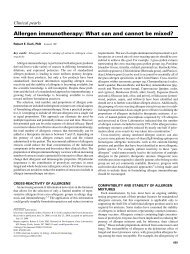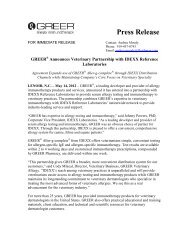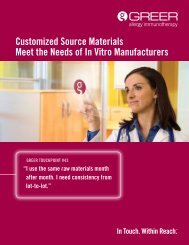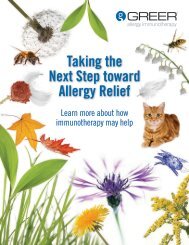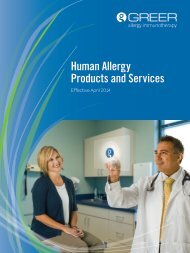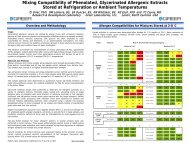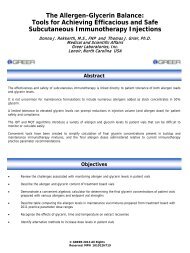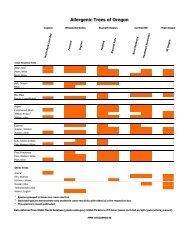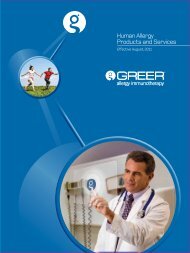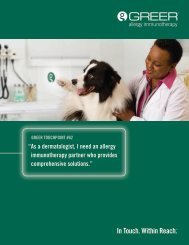Manufacturing and Standardizing Fungal Allergen Products - Greer
Manufacturing and Standardizing Fungal Allergen Products - Greer
Manufacturing and Standardizing Fungal Allergen Products - Greer
- No tags were found...
You also want an ePaper? Increase the reach of your titles
YUMPU automatically turns print PDFs into web optimized ePapers that Google loves.
J ALLERGY CLIN IMMUNOLVOLUME 113, NUMBER 2Esch 215facturing <strong>and</strong> quality controls for monitoring consistencycan reduce product variability. 19 However, if st<strong>and</strong>ardizationis to ensure consistency among productsmarketed by different manufacturers, then this goaldoes not appear possible for fungal allergen products.The marked differences in source materials <strong>and</strong> manufacturingprocedures used, the lack of generally acceptedpotency assays, <strong>and</strong> the great variety of potentiallyallergenic fungal species have impeded any significantprogress in fungal allergen st<strong>and</strong>ardization. Novel fungalst<strong>and</strong>ardization approaches have been suggested inthe past, including the pooling of selected relevantstrains to ensure an adequate complexity in composition.10,20 This approach requires knowledge of most orall relevant allergens <strong>and</strong> the development of new qualitycontrol procedures. The establishment of a wellcharacterizedreference preparation with a validatedpotency assay could facilitate allergen st<strong>and</strong>ardizationefforts. In the 1980s, an international collaborativegroup developed a reference st<strong>and</strong>ard of A alternataunder the auspices of the World Health Organization/InternationalUnion of Immunological Societiesallergen st<strong>and</strong>ardization committee. 21 This initiativefailed to gain wide acceptance by manufacturers,regulatory authorities, clinicians, <strong>and</strong> research laboratories.In 1997, the American Academy of Allergy, Asthma<strong>and</strong> Immunology <strong>Allergen</strong> St<strong>and</strong>ardization Committeeincluded Alternaria, Cladosporium, Penicillium,<strong>and</strong> Aspergillus species as priorities for allergen st<strong>and</strong>ardizationefforts. 22 There have been no new initiativesafter the publication of this position statement.CONCLUSIONS<strong>Fungal</strong> allergen extracts produced by the different USmanufacturers are highly variable in composition <strong>and</strong>should not be considered interchangeable. If one acceptsthis conclusion, then the total number of unique fungalallergen products marketed in the United States todayexceeds 200. St<strong>and</strong>ardization of fungal extracts or vaccineshas been <strong>and</strong> will continue to be difficult becausemanufacturers use distinctly different strains, cultivation<strong>and</strong> source material processing methods, extractionprocesses, <strong>and</strong> quality control procedures. In contrast toother allergen sources, such as Hymenoptera venoms,pollens, dust mites, <strong>and</strong> cat d<strong>and</strong>er, the limited knowledgeof relevant allergens <strong>and</strong> the lack of generallyaccepted reference reagents <strong>and</strong> validated potency assayshas impeded progress in developing a viable approachfor st<strong>and</strong>ardizing fungal vaccines. Improvement in thesafety, efficacy, <strong>and</strong> accuracy of fungal allergy diagnosis<strong>and</strong> immunotherapy will not be achieved without a coordinatedeffort by manufacturers, regulatory authorities,clinicians, <strong>and</strong> researchers.I thank Stewart Nielsen (Allermed), Shirley Williamson (Hollister-Stier),Peter Hauck (ALK-Abello), Fabio Cipolla (Nelco),Richard Bishop (Allergy Laboratories), Tom Willoughby (AntigenLabs), <strong>and</strong> Tom Grier (<strong>Greer</strong> Laboratories) for helpful discussions. Ialso thank Dawn Hazelhurst <strong>and</strong> Elizabeth Duncan (<strong>Greer</strong> Laboratories)for their technical expertise in performing the analytic tests.REFERENCES1. Aas K, Leegaard J, Aukrust L, Grimmer O. Immediate type hypersensitivityto common moulds. Allergy 1980;33:443-51.2. Weber RW. Cross-reactivity of plant <strong>and</strong> animal allergens. Clin RevAllergy Immunol 2001;21:153-202.3. Vijay HM, Thaker AJ, Banerjee B, Kurup VP. Mold allergens. In: LockeyRF, Bukantz SC, editors. <strong>Allergen</strong>s <strong>and</strong> allergen immunotherapy. 2nded. New York: Marcel Dekker, Inc; 1999. p. 133-54.4. Horner WE, Helbling A, Salvaggio JE, Lehrer SB. <strong>Fungal</strong> allergens. ClinMicrobiol Rev 1995;8:161-79.5. Shelton BG, Kirkl<strong>and</strong> KH, Fl<strong>and</strong>ers WD, Morris GK. Profiles of airbornefungi in buildings <strong>and</strong> outdoor environments in the United States. ApplEnviron Microbiol 2002;68:1743-53.6. Morrow MB, Meyer GH, Prince HE. A summary of air-borne mold surveys.Ann Allergy 1964;22:575-87.7. Prince HE, Halpin LJ, Talbett G, et al. Molds <strong>and</strong> bacteria in the etiologyof respiratory allergic diseases. XXI. Studies with mold extracts producedfrom cultures grown in modified synthetic media. Ann Allergy1961;19:259-67.8. Aukrust L, Borch SM, Einarsson R. Mold allergy: spores <strong>and</strong> myceliumas allergen sources. Allergy 1985;40(suppl 3):43-8.9. Arruda LK, Mann BJ, Chapman MD. Selective expression of a majorallergen <strong>and</strong> cytotoxin, Asp f I, in Aspergillus fumigatus. J Immunol1992;149:3354-9.10. Portnoy J, Pacecho F, Barnes C, Upadrastita B, Crenshaw R, Esch R.Selection of representative Alternaria strain groups on the basis of morphology,enzyme profile, <strong>and</strong> allergen content. J Allergy Clin Immunol1993;91:773-82.11. Nissen D, Petersen LJ, Esch R, et al. IgE-sensitization to cellular <strong>and</strong> culturefiltrates of fungal extracts in patients with atopic dermatitis. AnnAllergy 1998;81:247-55.12. Hauck PR, Williamson S. The manufacture of allergenic extracts in NorthAmerica. Clin Rev Allergy Immunol 2001;21:93-110.13. Vailes L, Sridhara S, Cromwell O, Weber B, Breitenbach M, ChapmanMD. Quantitation of the major fungal allergens Alt a 1 <strong>and</strong> Asp f 1, incommercial allergenic products. J Allergy Clin Immunol 2001;107:641-6.14. Yunginger JW, Jones RT, Gleich GJ. Studies on Alternaria allergens II.Measurement of the relative potency of commercial Alternaria extractsby direct RAST <strong>and</strong> by RAST-inhibition. J Allergy Clin Immunol1976;58:405-13.15. Esch RE. Role of proteases on the stability of allergenic extracts. In:Kurth R, editor. Regulatory control <strong>and</strong> st<strong>and</strong>ardization of allergenicextracts. Stuttgart: Gustav Fischer; 1991. p. 171-916. Kordash TR, Amend MJ, Williamson SL, Jones JK, Plunkett GA. Effectof mixing allergenic extracts containing Helminthosporium, D. farinae,<strong>and</strong> cockroach with perennial ryegrass. Ann Allergy 1993;71:240-6.17. Nelson HS, Ikle D, Buchmeier A. Studies of allergen extract stability: theeffects of dilution <strong>and</strong> mixing. J Allergy Clin Immunol 1996;98:382-8.18. ILi JT, Lockey RF, Bernstein IL, Portnoy JM, Nicklas A, editors. <strong>Allergen</strong>immunotherapy: a practice parameter. Joint Task Force on PracticeParameters. Ann Allergy 2003;90:1-50.19. Wahl R, Oliver JD, Hauck PR, Winter HG, Maasch HJ. Comparison ofAlternaria tenuis extracts prepared from different raw materials. AnnAllergy 1989;63:527-31.20. Steringer I, Aukrust L, Einarsson. Variability of antigenicity <strong>and</strong> allergenicityin different strains of Alternaria alternata. Int Arch Allergy ApplImmunol 1987;84:190-7.21. Helm RM, Squillace DL, Yuninger JW, Members of the InternationalCollaborative Trial. Production of a proposed international referencest<strong>and</strong>ard Alternaria extract. II. Results of collaborative trial. J AllergyClin Immunol 1988;81:651-63.22. AAAAI. Position statement. The use of st<strong>and</strong>ardized allergen extracts. JAllergy Clin Immunol 1997;99:583-6.Reviews <strong>and</strong>feature articles



